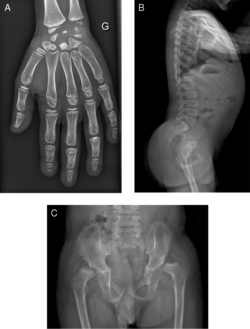Wolcott–Rallison syndrome
| Wolcott–Rallison syndrome | |
|---|---|

| |
| Synonyms | Early-onset diabetes mellitus with multiple epiphyseal dysplasia |
| Pronounce | N/A |
| Field | Pediatrics, Endocrinology, Medical genetics |
| Symptoms | Diabetes mellitus, epiphyseal dysplasia, osteopenia, developmental delay, hepatic failure, renal failure |
| Complications | Multisystem organ failure, intellectual disability |
| Onset | Infancy |
| Duration | Lifelong |
| Types | N/A |
| Causes | Autosomal recessive mutations in the EIF2AK3 gene |
| Risks | Consanguinity |
| Diagnosis | Genetic testing, clinical evaluation |
| Differential diagnosis | Neonatal diabetes, Fanconi syndrome, other syndromic forms of diabetes |
| Prevention | Genetic counseling |
| Treatment | Insulin therapy, supportive care for organ dysfunction |
| Medication | Insulin, levothyroxine (if hypothyroidism is present) |
| Prognosis | Guarded; depends on severity of organ involvement |
| Frequency | Very rare |
| Deaths | N/A |
Wolcott–Rallison syndrome, WRS, is a rare, autosomal recessive disorder with infancy-onset diabetes mellitus, multiple epiphyseal dysplasia, osteopenia, mental retardation or developmental delay, and hepatic and renal dysfunction as main clinical findings. Patients with WRS have mutations in the EIF2AK3 gene, which encodes the pancreatic eukaryotic translation initiation factor 2-alpha kinase 3.
Genetics[edit]
The main focus for this autosomal recessive disease is mutations to the EIF2AK3 gene. This gene is located on chromosome 2 p11.2. For some cases for unrelated families, identical mutations were observed, although these cases are rare.
The EIKF2AK3 gene codes for PERK (pancreatic endoplasmic reticulum kinase), an explanation for the spectrum symptoms. PERK is associated with the activity of beta cells in the pancreas. Beta cells are needed for the proper release of insulin into the blood stream after an increase in blood glucose. The endoplasmic reticulum is a major protein sorting and processing center in every cell of the body. A broad range of bodily systems is affected because of the lack of post-translational modifications of to proteins. These proteins are coming from the endoplasmic reticulum can be in the cells of the various organ systems effected, such as urinary and central nervous system. EIKF2AK3 is also involved in bone cells. This is part of the reason why patients suffer from multiple epiphyseal dysplasia and osteopenia.
Diagnosis[edit]
Initially, patients with neonatal or early-childhood onset diabetes are possible candidates for having Wolcott–Rallison syndrome. The other symptoms include the multiple epiphyseal dysplasia, osteopenia, intellectual disability, and hepatic and renal dysfunction.Hypothyroidism is rare is WRS patients but can occur.
Therapies[edit]
The most common method to manage hypoglycemia and diabetes is with an insulin pump. If needed, the patient can undergo thyroxin therapy in order to maintain proper thyroid stimulating hormone levels. This has only been needed in a few cases were hypothyroidism was present in the patient.
Ad. Transform your life with W8MD's Budget GLP-1 injections from $75


W8MD offers a medical weight loss program to lose weight in Philadelphia. Our physician-supervised medical weight loss provides:
- Weight loss injections in NYC (generic and brand names):
- Zepbound / Mounjaro, Wegovy / Ozempic, Saxenda
- Most insurances accepted or discounted self-pay rates. We will obtain insurance prior authorizations if needed.
- Generic GLP1 weight loss injections from $75 for the starting dose.
- Also offer prescription weight loss medications including Phentermine, Qsymia, Diethylpropion, Contrave etc.
NYC weight loss doctor appointmentsNYC weight loss doctor appointments
Start your NYC weight loss journey today at our NYC medical weight loss and Philadelphia medical weight loss clinics.
- Call 718-946-5500 to lose weight in NYC or for medical weight loss in Philadelphia 215-676-2334.
- Tags:NYC medical weight loss, Philadelphia lose weight Zepbound NYC, Budget GLP1 weight loss injections, Wegovy Philadelphia, Wegovy NYC, Philadelphia medical weight loss, Brookly weight loss and Wegovy NYC
|
WikiMD's Wellness Encyclopedia |
| Let Food Be Thy Medicine Medicine Thy Food - Hippocrates |
Medical Disclaimer: WikiMD is not a substitute for professional medical advice. The information on WikiMD is provided as an information resource only, may be incorrect, outdated or misleading, and is not to be used or relied on for any diagnostic or treatment purposes. Please consult your health care provider before making any healthcare decisions or for guidance about a specific medical condition. WikiMD expressly disclaims responsibility, and shall have no liability, for any damages, loss, injury, or liability whatsoever suffered as a result of your reliance on the information contained in this site. By visiting this site you agree to the foregoing terms and conditions, which may from time to time be changed or supplemented by WikiMD. If you do not agree to the foregoing terms and conditions, you should not enter or use this site. See full disclaimer.
Credits:Most images are courtesy of Wikimedia commons, and templates, categories Wikipedia, licensed under CC BY SA or similar.
Translate this page: - East Asian
中文,
日本,
한국어,
South Asian
हिन्दी,
தமிழ்,
తెలుగు,
Urdu,
ಕನ್ನಡ,
Southeast Asian
Indonesian,
Vietnamese,
Thai,
မြန်မာဘာသာ,
বাংলা
European
español,
Deutsch,
français,
Greek,
português do Brasil,
polski,
română,
русский,
Nederlands,
norsk,
svenska,
suomi,
Italian
Middle Eastern & African
عربى,
Turkish,
Persian,
Hebrew,
Afrikaans,
isiZulu,
Kiswahili,
Other
Bulgarian,
Hungarian,
Czech,
Swedish,
മലയാളം,
मराठी,
ਪੰਜਾਬੀ,
ગુજરાતી,
Portuguese,
Ukrainian